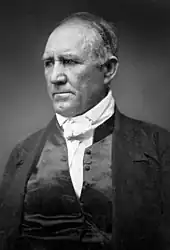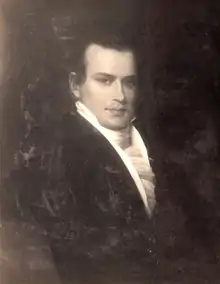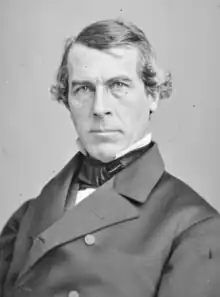| 1860 presidential election | |
  Nominees Bell and Everett | |
| Convention | |
|---|---|
| Date(s) | May 9–10, 1860 |
| City | Baltimore, Maryland |
| Candidates | |
| Presidential nominee | John Bell of Tennessee |
| Vice presidential nominee | Edward Everett of Massachusetts |
The 1860 Constitutional Union National Convention met on May 9, 1860, in Baltimore, Maryland. It was the only national convention ever held by the Constitutional Union Party, which was organized largely by former Whig Party members from the Southern United States who opposed secession. The convention nominated former Senator John Bell of Tennessee for president and former Secretary of State Edward Everett of Massachusetts for vice president.
Bell won the presidential nomination on the second ballot of the convention, defeating Everett, Governor Sam Houston of Texas, Senator John J. Crittenden of Kentucky, former Governor William Alexander Graham of North Carolina, Associate Justice John McLean of Ohio, and several other candidates. In the 1860 presidential election, Bell and Everett finished third in the electoral vote and fourth in the popular vote.
Background
After the passage of the Kansas-Nebraska Act in 1854, the Whigs collapsed due to divisions over slavery. Many Northern Whigs shifted to the new Republican Party, while many Southern Whigs joined the American Party, or "Know Nothings."[1]: 304 By 1859, the Know Nothing movement had collapsed, but some former Southern Whigs who refused to join their long-time rivals in the Democratic Party had organized themselves into the "Opposition Party." Several of this party's supporters, among them Knoxville Whig editor William Brownlow, former vice presidential candidate Andrew Jackson Donelson, and California attorney Balie Peyton sought to launch a third-party presidential ticket.[1]: 346
In May 1860, disgruntled ex-Whigs and disenchanted moderates from across the country convened in Baltimore, where they formed the Constitutional Union Party. The party's platform was very broad and made no mention of slavery. While there were several candidates for the party's presidential nomination, the two frontrunners were Bell and Sam Houston.[1]: 354
Presidential nomination
Presidential candidates

Bell led the initial round of balloting with 68.5 votes to Houston's 59. The remainder of the votes were split among eight other candidates. Houston's military endeavors had brought him national renown, but he reminded the convention's Clay Whigs of their old foe Andrew Jackson. On May 10, Bell received 139 votes to Houston's 69, and was declared the candidate.[1]: 354
| Presidential Ballot | ||
|---|---|---|
| Ballot | 1st | 2nd (Before Shifts) |
| Bell | 68.5 | 139 |
| Houston | 57 | 69 |
| Crittenden | 28 | 1 |
| Everett | 25 | 9.5 |
| Graham | 22 | 18.5 |
| McLean | 21 | 1 |
| Rives | 13 | 0 |
| Botts | 9.5 | 7.5 |
| Sharkey | 7 | 8.5 |
| Goggin | 3 | 0 |
| Not Represented | 49 | 49 |
Presidential Balloting / 2nd Day of Convention (May 10, 1860)
 1st Presidential Ballot
1st Presidential Ballot 2nd Presidential Ballot
2nd Presidential Ballot
(Before Shifts)
Vice presidential nomination
Vice presidential candidates
The vice presidential nomination went to Edward Everett of Massachusetts, who had served as president of Harvard University and as Secretary of State in the Fillmore administration. Everett was nominated by acclaimation.
References
- 1 2 3 4 Joseph Parks, John Bell of Tennessee (Baton Rouge: Louisiana State University Press, 1950).
- ↑ John Bell was a former U.S. Senator, Speaker of the United States House of Representatives, U.S. Secretary of War
- ↑ Sam Houston was a sitting Governor of Texas, former U.S. Senator, President of the Republic of Texas, Governor of Tennessee, and U.S. Representative (Tennessee-7)
- ↑ John Crittenden was a sitting U.S. Senator, former U.S. Attorney General, Governor of Kentucky, U.S. Representative (Kentucky-8)
- ↑ Edward Everett was a former U.S. Senator, U.S. Secretary of State, U.S. Minister to the United Kingdom, Governor of Massachusetts, U.S. Representative (Massachusetts-4)
- ↑ William A. Graham was a former U.S. Senator, Governor of North Carolina, U.S. Secretary of the Navy
- ↑ William C. Rives was a former U.S. Senator 1832–1834, and again 1836-1845





